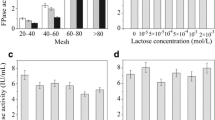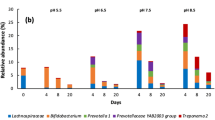Abstract
The ruminal cellulolytic bacterium Fibrobacter succinogenes S85 was grown in cellulose-fed continuous culture at 22 different combinations of dilution rate (D, 0.014–0.076 h-1) and extracellular pH (6.11–6.84). Effects of pH and D on the fermentation were determined by subjecting data on cellulose consumption, cell yield, product yield (succinate, acetate, formate), and soluble sugar concentrationto response surface analysis. The extent of cellulose conversion decreased with increasing D. First-order rate constants at rapid growth rates were estimated as 0.07–0.11 h-1, and decreased with decreasing pH. Apparent decreases in the rate constant with increasing D was not due to inadequate mixing or preferential utilization of the more amorphous regions of the cellulose. Significant quantities of soluble sugars (0.04–0.18 g/l, primarily glucose) were detected in all cultures, suggesting that glucose uptake was rather inefficient. Cell yields (0.11–0.24 g cells/g cellulose consumed) increased with increasing D. Pirt plots of the predicted yield data were used to determined that maintenance coefficient (0.04–0.06 g cellulose/g cells · h) and true growth yield (0.23–0.25 g cells/g cellulose consumed) varied slightly with pH. Yields of succinate, the major fermentation endproduct, were as high as 1.15 mol/mol anhydroglucose fermented, and were slightly affected by dilution rate but were not affected by pH. Comparison of the fermentation data with that of other ruminal cellulolytic bacteria indicates that F. succinogenes S85 is capable of rapid hydrolysis of crystalline cellulose and efficient growth, despite a lower μmax on microcrystalline cellulose.
Similar content being viewed by others
References
Allen MS, Mertens DR (1988) Evaluating constraints on fiber digestion by rumen microbes. J Nutr 118: 261–270
Chow JM, Russell JB (1992) Effect of pH and monensin on glucose transport by Fibrobacter succinogenes, a cellulolytic ruminal bacterium. Appl Environ Microbiol 58: 1115–1120
Groleau D, Forsberg CW (1981) Cellulolytic activity of the rumen bacterium Bacteroides succinogenes. Can J Microbiol 27: 517–530
Halliwell G, Bryant MP (1963) The cellulolytic activity of pure strains of bacteria from the rumen of cattle. J Gen Microbiol 32: 441–448
Huang L, Forsberg CW (1990) Cellulose digestion and cellulose regulation and distribution in Fibrobacter succinogenes subsp. succinogenes S85. Appl Environ Microbiol 56: 1221–1228
Hungate RE (1959) Microbial fermentation in certain mammals. Science 130: 1192–1194
IUPAC Commission on Biotechnology (1987) Measurement of cellulase activities. Pure Appl Chem 59: 258–268
Kudo H, Cheng KJ, Costerton JW (1987) Electron microscopic study of the methylcellulose-mediated detachment of cellulolytic rumen bacteria from cellulose fibers. Can J Microbiol 33: 267–272
Latham MJ, Brooker BE, Pettipher GL, Harris PJ (1978) Adhesion of Bacteroides succinogenes in pure culture and in the presence of Ruminococcus flavefaciens to cell walls in leaves of perennial ryegrass (Lolium perenne). Appl Environ Microbiol 35: 1166–1173
Lee YH, Fan LT (1982) Kinetic studies of enzymatic hydrolysis of insoluble cellulose: analysis of the initial rates. Biotechnol Bioeng 24: 2383–2406
McGavin M, Forsberg CW (1988) Isolation and characterization of endoglucanases 1 and 2 from Bacteroides succinogenes S85. J Bacteriol 170: 2914–2922
McGavin M, Lam J, Forsberg CW (1990) Regulation and distribution of Fibrobacter succinogenes subsp. succinogenes S85 endoglucanases. Appl Environ Microbiol 56: 1235–1244
Melville SB, Michel TM, Macy JM (1988) Regulation of carbon flow in Selenomonas ruminantium grown in glucose-limited continuous culture. J Bacteriol 170: 5305–5311
Miller TL (1978) The pathway of formation of acetate and succinate from pyruvate by Bacteroides succinogenes. Arch Microbiol 117: 145–152
Miller GL, Blum R, Glennon WE, Burton AL (1960) Analysis of carboxymethylcellulase activity. Anal Biochem 2: 127–132
Pavlostathis SG, Miller TL, Wolin MJ (1988a) Fermentation of insoluble cellulose by continuous cultures of Ruminococcus albus. Appl Environ Microbiol 54: 2655–2559
Pavlostathis SG, Miller TL, Wolin MJ (1988b) Kinetics of insoluble cellulose fermentation by continuous cultures of Ruminococcus albus. Appl Environ Microbiol 54: 2660–2663
Russell JB, Dombrowski DB (1980) Effect of pH on the efficiency of growth by pure cultures of rumen bacteria in continuous culture. Appl Environ Microbiol 39: 604–610
Shi Y, Weimer PJ (1992) Response surface analysis of the effects of dilution rate and pH on Ruminococcus flavefaciens in cellulose-fed continuous culture. Appl Environ Microbiol 58: 2583–2591
Stewart CS (1977) Factors affecting the cellulolytic activity of rumen contents. Appl Environ Microbiol 33: 497–502
Stewart CS, Flint HJ (1989) Bacteroides (Fibrobacter) succinogenes, a cellulolytic anaerobic bacterium from the gastrointestinal tract Appl Microbiol Biotechnol 40: 433–439
Weimer PJ, Weston WM (1985) Relationship between the fine structure of native cellulose and cellulose degradability by the cellulase complexes of Trichoderma reesei and Clostridium thermocellum. Biotechnol Bioeng 27: 1540–1547
Weimer PJ, Lopez-Guisa JM, French AD (1990) Effect of cellulose fine structure on kinetics of its digestion by mixed ruminal microorganisms in vitro. Appl Environ Microbiol 56: 2421–2429
Weimer PJ, Shi Y, Odt CL (1991) A segmented gas/liquid delivery system for continuous culture of microorganisms on insoluble substrates and its use for growth of Ruminococcus flavefaciens on cellulose. Appl Microbiol Biotechnol 36: 178–183
Weimer PJ, Hatfield RD, Buxton DR (1993) Inhibition of ruminal cellulose fermentation by extracts of the perennial legume cicer milkvetch (Astragalus cicer). Appl Environ Microbiol 59: 504–509
Author information
Authors and Affiliations
Rights and permissions
About this article
Cite this article
Weimer, P.J. Effects of dilution rate and pH on the ruminal cellulolytic bacterium Fibrobacter succinogenes S85 in cellulose-fed continuous culture. Arch. Microbiol. 160, 288–294 (1993). https://doi.org/10.1007/BF00292079
Received:
Accepted:
Issue Date:
DOI: https://doi.org/10.1007/BF00292079




